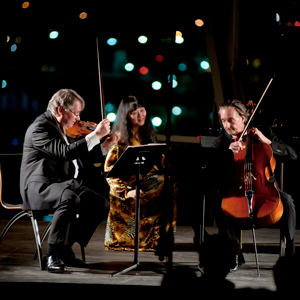by Daniel Hathaway

Last April, the three musicians played the first and third trios from Op. 1 and the “Archduke,” Op. 97. On October 27, they’ll finish the cycle with the G-Major Trio (Op. 1, No. 2), the D-Major Trio (Op. 70, No. 1), and the “Ghost” Trio in E-flat (Op. 70, No. 2). (Read a review of their March performance here.)
Wu Han and Setzer will speak about the Beethoven trios in a 6:30 pre-concert lecture. Before the first concert in this challenging undertaking, we reached the effervescent pianist by cell phone to talk about how the project came about and what it was like to program all six of Beethoven’s piano trios in two performances. Here are some excerpts from that conversation.
DH: How did you decide to take on all of the Beethoven piano trios?
WH: This project is something David, Phil Setzer, and I have been dreaming about for years. Starting with Akron this April, we will be performing all of the Beethoven piano trios — except the one with clarinet. We’ll play six of them across two concerts. Akron will be the first installment of the first program: Op. 1, Nos. 1 and 3, and then the “Archduke” Trio. We’ll return to Akron next season to finish the cycle with the “Ghost” Trio, then Op. 1, No. 2, and finally Op. 70, No. 2.
We actually already tried out the program in West Palm Beach two weeks ago. Originally, the presenter said he liked the idea of an all-Beethoven program, but he couldn’t possibly take all of the trios. Then the audience went so crazy, he asked if we could come back and finish the cycle. Next season we have over 20 concerts for this project. Some presenters are taking it as a two-year cycle, some as a two-day event, and some with all six in one day with a dinner break in the middle. I just can’t believe it. People say classical music isn’t thriving, but I see so many people who are passionate about it.
DH: Beethoven was a young, hotshot pianist when he wrote Op. 1, and he obviously wanted to show off his skills. Do things get easier for the performer between Op. 1 and Op. 97?
WH: I have to say that for me, all three in Op. 1 are the most difficult. It’s the same for the early piano sonatas, like Op. 10. You have to play them with the grace of Mozart and the inventiveness of Haydn, but with the character of Beethoven. Also they’re very exposed, just like a Mozart sonata.
Beethoven used Op. 1 to make a name for himself in Vienna. It was a very important statement for him in terms of publishing. Apparently Haydn heard Op. 1, No. 3 and claimed that it was too difficult and advised him not to publish it. But the genius part is that if you look at how he grouped the three pieces all under Op. 1, you really understand the thinking behind it.
They’re three drastically different pieces. No. 1 is delightful and joyous. No. 2 is grand and like a symphony, but it has the wackiest last movement. No. 3 is tragic, dramatic, and depressing. He used these three pieces to show the dimensions he could produce. And this was the first set of trios he wrote on a grand scale. I don’t think you’ll find a four-movement trio in Mozart or Haydn. This was the first time he put in a scherzo and a substantial slow movement. So the Op. 1 trios represent a landmark in Beethoven’s compositions. I’m so in love with these pieces. Apparently he earned something like two years’ salary out of these three works. They’re totally fascinating and totally out of the ordinary. They’re not like any trios you’ve heard before.
DH: I understand you’re going to be giving the pre-concert lecture before the Akron concert.
WH: Yes. Phil and I will take some of the pieces apart and show the audience this and that so they can understand things from the performers’ point of view.
DH: I joke about the fact that you’re the longest-living piano trio without a name. And nobody knows what order to list your names in.
WH: (Laughs) It’s deliberately done that way. When we first started to play as a trio, everybody asked us for a name. We all decided that once we had a name, nobody would know who we were. You know how many times David and I played recitals in the same season as the Emerson Quartet. The Quartet would go first, and after we played our recital, without fail someone would walk up to David and say, “You know, you look very familiar.” And he would say, “Oh, I don’t think so.” If you asked people who the second violinist in the Emerson Quartet is, they wouldn’t know, but they would know about the Quartet.
Another thing about this trio is we love playing with each other so much. We decided that if we didn’t take on a name, we’d be sure to continue. It’s like a short-term commitment, and we go from season to season. Every year our manager calls us and asks if we still want to do the trio. I say, “Let me think about it. I’ll ask the others.” I’m not kidding. We never officially formed the trio.
We started with Schubert, just as a project. We gave our manager, David Rowe, a 14-day period. He booked 12 of them, and all the presenters asked if we could do a second year. Next came Mendelssohn, then Dvořák. It’s very repertoire-driven. There’s zero career talk, no mention of publicity photos or PR and all that. It’s just, ‘let’s play Beethoven trios. Let’s make a tape. That sounds really good, maybe we should record it.’ It’s like that. It’s kind of funny.
Published on ClevelandClassical.com October 20, 2015.
Click here for a printable copy of this article



